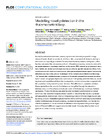Modelling novelty detection in the thalamocortical loop
dc.contributor.author
Vasilaki, Eleni
dc.contributor.author
Han, Chao
dc.contributor.author
English, Gwendolyn
dc.contributor.author
Saal, Hannes P.
dc.contributor.author
Indiveri, Giacomo
dc.contributor.author
Gilra, Aditya
dc.contributor.author
von der Behrens, Wolfger
dc.date.accessioned
2023-05-31T13:38:29Z
dc.date.available
2023-05-31T12:42:52Z
dc.date.available
2023-05-31T13:38:29Z
dc.date.issued
2023-05
dc.identifier.issn
1553-734X
dc.identifier.issn
1553-7358
dc.identifier.other
10.1371/journal.pcbi.1009616
en_US
dc.identifier.uri
http://hdl.handle.net/20.500.11850/614515
dc.identifier.doi
10.3929/ethz-b-000614515
dc.description.abstract
In complex natural environments, sensory systems are constantly exposed to a large stream of inputs. Novel or rare stimuli, which are often associated with behaviorally important events, are typically processed differently than the steady sensory background, which has less relevance. Neural signatures of such differential processing, commonly referred to as novelty detection, have been identified on the level of EEG recordings as mismatch negativity (MMN) and on the level of single neurons as stimulus-specific adaptation (SSA). Here, we propose a multi-scale recurrent network with synaptic depression to explain how novelty detection can arise in the whisker-related part of the somatosensory thalamocortical loop. The “minimalistic” architecture and dynamics of the model presume that neurons in cortical layer 6 adapt, via synaptic depression, specifically to a frequently presented stimulus, resulting in reduced population activity in the corresponding cortical column when compared with the population activity evoked by a rare stimulus. This difference in population activity is then projected from the cortex to the thalamus and amplified through the interaction between neurons of the primary and reticular nuclei of the thalamus, resulting in rhythmic oscillations. These differentially activated thalamic oscillations are forwarded to cortical layer 4 as a late secondary response that is specific to rare stimuli that violate a particular stimulus pattern. Model results show a strong analogy between this late single neuron activity and EEG-based mismatch negativity in terms of their common sensitivity to presentation context and timescales of response latency, as observed experimentally. Our results indicate that adaptation in L6 can establish the thalamocortical dynamics that produce signatures of SSA and MMN and suggest a mechanistic model of novelty detection that could generalize to other sensory modalities.
en_US
dc.format
application/pdf
en_US
dc.language.iso
en
en_US
dc.publisher
PLOS
en_US
dc.rights.uri
http://creativecommons.org/licenses/by/4.0/
dc.title
Modelling novelty detection in the thalamocortical loop
en_US
dc.type
Journal Article
dc.rights.license
Creative Commons Attribution 4.0 International
dc.date.published
2023-05-15
ethz.journal.title
PLoS Computational Biology
ethz.journal.volume
19
en_US
ethz.journal.issue
5
en_US
ethz.journal.abbreviated
PLOS comput. biol.
ethz.pages.start
e1009616
en_US
ethz.size
35 p.
en_US
ethz.version.deposit
publishedVersion
en_US
ethz.identifier.wos
ethz.identifier.scopus
ethz.publication.place
San Francisco, CA
en_US
ethz.publication.status
published
en_US
ethz.leitzahl
ETH Zürich::00002 - ETH Zürich::00012 - Lehre und Forschung::00007 - Departemente::02140 - Dep. Inf.technologie und Elektrotechnik / Dep. of Inform.Technol. Electrical Eng.::02533 - Institut für Neuroinformatik / Institute of Neuroinformatics::09699 - Indiveri, Giacomo / Indiveri, Giacomo
en_US
ethz.leitzahl
ETH Zürich::00002 - ETH Zürich::00012 - Lehre und Forschung::00007 - Departemente::02140 - Dep. Inf.technologie und Elektrotechnik / Dep. of Inform.Technol. Electrical Eng.::02533 - Institut für Neuroinformatik / Institute of Neuroinformatics::09474 - Yanik, Mehmet Fatih / Yanik, Mehmet Fatih
en_US
ethz.leitzahl.certified
ETH Zürich::00002 - ETH Zürich::00012 - Lehre und Forschung::00007 - Departemente::02140 - Dep. Inf.technologie und Elektrotechnik / Dep. of Inform.Technol. Electrical Eng.::02533 - Institut für Neuroinformatik / Institute of Neuroinformatics::09474 - Yanik, Mehmet Fatih / Yanik, Mehmet Fatih
en_US
ethz.leitzahl.certified
ETH Zürich::00002 - ETH Zürich::00012 - Lehre und Forschung::00007 - Departemente::02140 - Dep. Inf.technologie und Elektrotechnik / Dep. of Inform.Technol. Electrical Eng.::02533 - Institut für Neuroinformatik / Institute of Neuroinformatics::09699 - Indiveri, Giacomo / Indiveri, Giacomo
en_US
ethz.relation.isNewVersionOf
10.3929/ethz-b-000529297
ethz.date.deposited
2023-05-31T12:42:52Z
ethz.source
FORM
ethz.eth
yes
en_US
ethz.availability
Open access
en_US
ethz.rosetta.installDate
2024-02-02T23:51:36Z
ethz.rosetta.lastUpdated
2024-02-02T23:51:36Z
ethz.rosetta.versionExported
true
ethz.COinS
ctx_ver=Z39.88-2004&rft_val_fmt=info:ofi/fmt:kev:mtx:journal&rft.atitle=Modelling%20novelty%20detection%20in%20the%20thalamocortical%20loop&rft.jtitle=PLoS%20Computational%20Biology&rft.date=2023-05&rft.volume=19&rft.issue=5&rft.spage=e1009616&rft.issn=1553-734X&1553-7358&rft.au=Vasilaki,%20Eleni&Han,%20Chao&English,%20Gwendolyn&Saal,%20Hannes%20P.&Indiveri,%20Giacomo&rft.genre=article&rft_id=info:doi/10.1371/journal.pcbi.1009616&
Files in this item
Publication type
-
Journal Article [128983]

